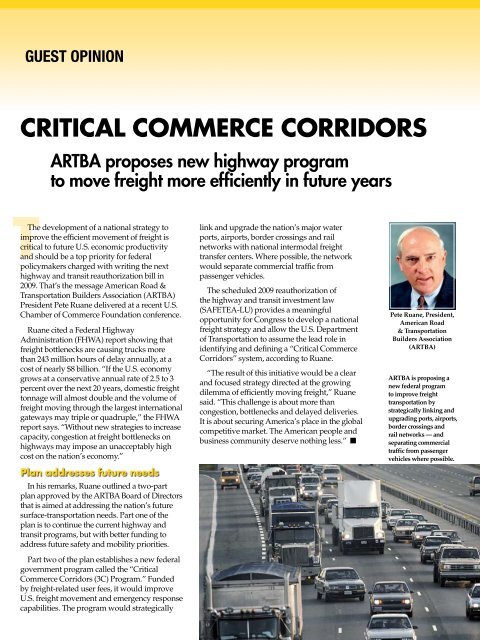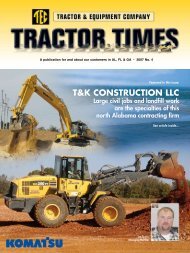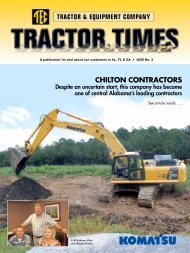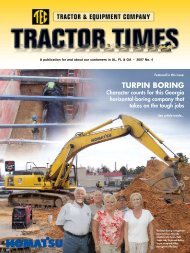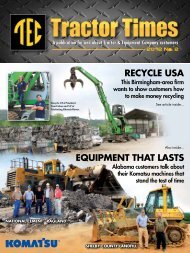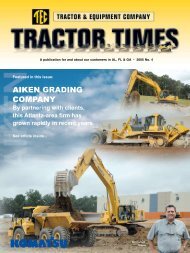EARTHWORKS GRADING & CONCRETE - TEC Tractor Times
EARTHWORKS GRADING & CONCRETE - TEC Tractor Times
EARTHWORKS GRADING & CONCRETE - TEC Tractor Times
You also want an ePaper? Increase the reach of your titles
YUMPU automatically turns print PDFs into web optimized ePapers that Google loves.
GUEST OPINION<br />
CRITICAL COMMERCE CORRIDORS<br />
ARTBA proposes new highway program<br />
to move freight more efficiently in future years<br />
TThe development of a national strategy to<br />
improve the efficient movement of freight is<br />
critical to future U.S. economic productivity<br />
and should be a top priority for federal<br />
policymakers charged with writing the next<br />
highway and transit reauthorization bill in<br />
2009. That’s the message American Road &<br />
Transportation Builders Association (ARTBA)<br />
President Pete Ruane delivered at a recent U.S.<br />
Chamber of Commerce Foundation conference.<br />
Ruane cited a Federal Highway<br />
Administration (FHWA) report showing that<br />
freight bottlenecks are causing trucks more<br />
than 243 million hours of delay annually, at a<br />
cost of nearly $8 billion. “If the U.S. economy<br />
grows at a conservative annual rate of 2.5 to 3<br />
percent over the next 20 years, domestic freight<br />
tonnage will almost double and the volume of<br />
freight moving through the largest international<br />
gateways may triple or quadruple,” the FHWA<br />
report says. “Without new strategies to increase<br />
capacity, congestion at freight bottlenecks on<br />
highways may impose an unacceptably high<br />
cost on the nation’s economy.”<br />
Plan addresses future needs<br />
In his remarks, Ruane outlined a two-part<br />
plan approved by the ARTBA Board of Directors<br />
that is aimed at addressing the nation’s future<br />
surface-transportation needs. Part one of the<br />
plan is to continue the current highway and<br />
transit programs, but with better funding to<br />
address future safety and mobility priorities.<br />
Part two of the plan establishes a new federal<br />
government program called the “Critical<br />
Commerce Corridors (3C) Program.” Funded<br />
by freight-related user fees, it would improve<br />
U.S. freight movement and emergency response<br />
capabilities. The program would strategically<br />
link and upgrade the nation’s major water<br />
ports, airports, border crossings and rail<br />
networks with national intermodal freight<br />
transfer centers. Where possible, the network<br />
would separate commercial traffic from<br />
passenger vehicles.<br />
The scheduled 2009 reauthorization of<br />
the highway and transit investment law<br />
(SAFETEA-LU) provides a meaningful<br />
opportunity for Congress to develop a national<br />
freight strategy and allow the U.S. Department<br />
of Transportation to assume the lead role in<br />
identifying and defining a “Critical Commerce<br />
Corridors” system, according to Ruane.<br />
“The result of this initiative would be a clear<br />
and focused strategy directed at the growing<br />
dilemma of efficiently moving freight,” Ruane<br />
said. “This challenge is about more than<br />
congestion, bottlenecks and delayed deliveries.<br />
It is about securing America’s place in the global<br />
competitive market. The American people and<br />
business community deserve nothing less.” n<br />
Pete Ruane, President,<br />
American Road<br />
& Transportation<br />
Builders Association<br />
(ARTBA)<br />
ARTBA is proposing a<br />
new federal program<br />
to improve freight<br />
transportation by<br />
strategically linking and<br />
upgrading ports, airports,<br />
border crossings and<br />
rail networks — and<br />
separating commercial<br />
traffic from passenger<br />
vehicles where possible.


